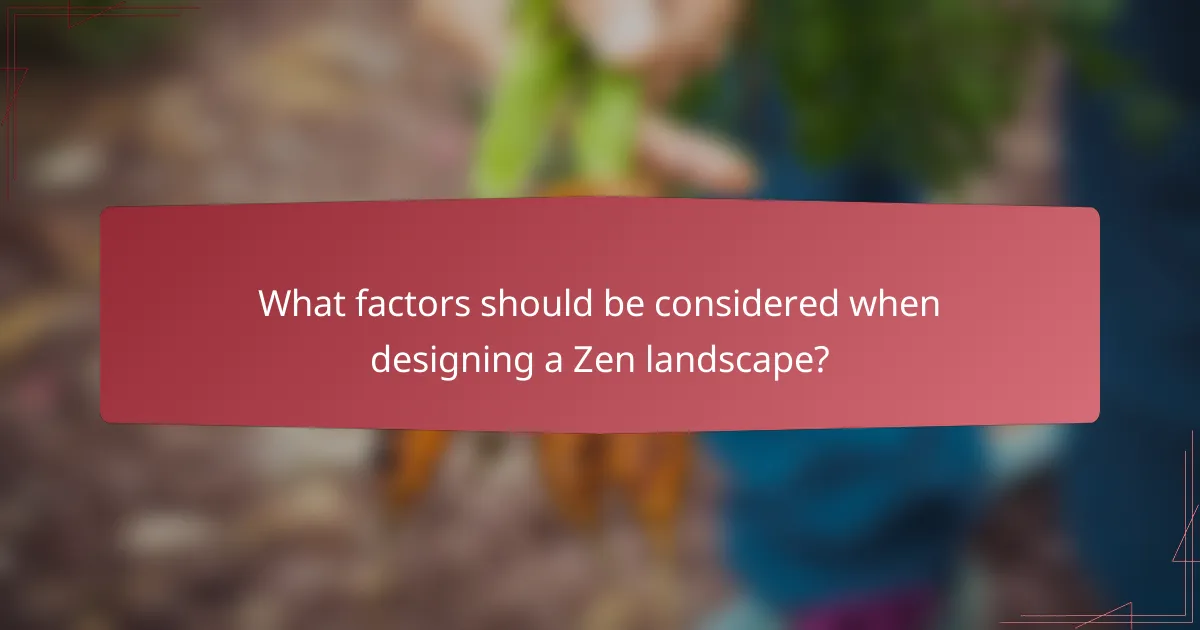Zen landscaping is a harmonious approach to creating tranquil environments that foster relaxation and mindfulness, especially in urban settings. By integrating natural elements like carefully arranged rocks and simple aesthetics, these landscapes offer a peaceful retreat from the chaos of city life, promoting a sense of serenity and reflection.

How can Zen Landscaping enhance tranquility in urban areas?
Zen landscaping enhances tranquility in urban areas by creating serene environments that promote relaxation and mindfulness. By incorporating natural elements and simple aesthetics, these landscapes provide a peaceful retreat from the hustle and bustle of city life.
Incorporating water features
Water features, such as ponds or small fountains, play a crucial role in Zen landscaping by introducing soothing sounds and visual appeal. The gentle flow of water can mask urban noise, creating a calming atmosphere. Consider using recirculating systems to minimize maintenance and water usage.
When selecting a water feature, think about size and placement. A small fountain can fit in tight spaces, while a larger pond may require more room but offers greater biodiversity. Aim for features that blend seamlessly with the surrounding landscape.
Using native plants
Native plants are essential in Zen landscaping as they are adapted to the local climate and soil, requiring less maintenance and water. These plants not only enhance the aesthetic but also support local wildlife, contributing to a balanced ecosystem. Examples include grasses, shrubs, and flowering plants that thrive in your area.
When designing your landscape, choose a variety of native species to create layers and textures. Grouping plants with similar water and sunlight needs can simplify care and improve the overall health of your garden.
Creating quiet zones
Quiet zones are integral to fostering tranquility in urban landscapes. These areas can be designed with comfortable seating, soft landscaping, and minimal distractions, allowing individuals to unwind and reflect. Consider using natural barriers like hedges or boulders to define these spaces.
To enhance the experience, incorporate elements like soft lighting or shaded areas for comfort. Regular maintenance is key to keeping these zones inviting, so plan for seasonal clean-ups and plant care to maintain their peaceful ambiance.

What are the key rock features in Zen Landscaping?
Key rock features in Zen landscaping include elements that promote tranquility and simplicity, such as carefully arranged stones and natural rock formations. These features create a serene environment, enhancing the aesthetic appeal while encouraging mindfulness and relaxation.
Zen rock gardens
Zen rock gardens, or karesansui, are minimalist landscapes that use rocks, gravel, and sand to represent natural elements. The arrangement of these materials is crucial, as it symbolizes water, mountains, and other natural features, promoting a sense of peace. Raking patterns in the gravel can mimic waves or ripples, adding to the tranquil atmosphere.
To create a Zen rock garden, select a flat area and outline the space with stones. Use fine gravel or sand for the base, and incorporate larger rocks to serve as focal points. Regular maintenance, such as raking and replacing gravel, is essential to preserve its aesthetic quality.
Stone pathways
Stone pathways are integral to Zen landscaping, guiding visitors through the garden while enhancing its natural beauty. These paths can be made from flat stones, pebbles, or gravel, allowing for a variety of textures and appearances. The layout should encourage slow, mindful walking, promoting reflection and tranquility.
When designing stone pathways, consider the width and spacing of the stones to ensure comfort and accessibility. A width of around 60-90 cm is often suitable for easy navigation. Incorporating surrounding plants can soften the edges and create a harmonious blend with the landscape.
Rock formations
Rock formations in Zen landscaping serve as focal points and can represent mountains or islands in a larger landscape. These formations should be arranged thoughtfully to create balance and harmony, often following the principles of asymmetry and naturalness. The size and shape of the rocks can significantly influence the overall aesthetic.
To effectively use rock formations, select stones of varying sizes and textures. Position larger rocks in the foreground to draw attention, while smaller stones can fill in gaps or create layers. Aim for a natural look, avoiding overly symmetrical arrangements, to enhance the serene atmosphere of the garden.

How do simple aesthetics contribute to Zen Landscaping?
Simple aesthetics play a crucial role in Zen landscaping by promoting tranquility and harmony through minimalism. This approach emphasizes clean lines, uncluttered spaces, and a focus on natural elements, allowing for a serene environment that encourages reflection and mindfulness.
Minimalist design principles
Minimalist design principles in Zen landscaping prioritize simplicity and functionality. By reducing visual clutter, the landscape becomes a peaceful retreat, where each element serves a purpose and contributes to the overall harmony. Key principles include open spaces, balanced proportions, and a limited number of focal points.
When implementing minimalist design, consider using geometric shapes and asymmetry to create visual interest without overwhelming the senses. For example, a single stone lantern or a carefully placed boulder can serve as a focal point while maintaining a serene atmosphere.
Color palette selection
The color palette in Zen landscaping is typically subdued, focusing on natural hues that evoke calmness. Earthy tones such as greens, browns, and soft grays are commonly used, as they blend seamlessly with the surrounding environment. This restrained color scheme helps to create a cohesive and tranquil space.
To enhance the Zen aesthetic, consider using a limited color palette with subtle variations. For instance, incorporating different shades of green through various plants can add depth without disrupting the overall simplicity. Avoid bright or clashing colors that may create visual noise.
Natural materials usage
Natural materials are essential in Zen landscaping, as they promote a connection to the environment and enhance the tranquil atmosphere. Common materials include stone, wood, gravel, and water features, each contributing to the overall simplicity and organic feel of the landscape.
When selecting materials, prioritize those that are locally sourced and sustainable. For example, using local stones for pathways or native plants for gardens not only supports the environment but also helps the landscape blend harmoniously with its surroundings. Avoid synthetic materials that can disrupt the natural aesthetic.

What are the benefits of Zen Landscaping for local homeowners?
Zen landscaping offers homeowners a serene outdoor environment that promotes tranquility and simplicity. By incorporating natural elements like rocks and minimalistic designs, it enhances the aesthetic appeal while providing practical benefits.
Increased property value
Zen landscaping can significantly boost property value by creating an attractive and unique outdoor space. Homes with well-designed landscapes often sell for higher prices, as potential buyers appreciate the low-maintenance and visually appealing features.
Investing in Zen landscaping can yield returns of 10-15% on property value, depending on the local market. Simple rock features and carefully placed plants can transform an ordinary yard into a desirable oasis.
Reduced maintenance costs
One of the key advantages of Zen landscaping is its low maintenance requirements. By using drought-resistant plants and natural materials, homeowners can minimize ongoing upkeep, saving both time and money.
For example, replacing traditional grass lawns with gravel or stone can cut down on watering and mowing costs. This approach not only conserves resources but also reduces the need for chemical fertilizers and pesticides, making it an eco-friendly choice.
Enhanced outdoor living spaces
Zen landscaping creates inviting outdoor spaces that encourage relaxation and social interaction. Features like rock gardens, water elements, and simple seating areas can transform a backyard into a peaceful retreat.
Homeowners can enhance their outdoor living experience by incorporating elements such as bamboo screens or stone pathways. These features not only improve aesthetics but also provide functional spaces for gatherings, meditation, or quiet reflection.

What factors should be considered when designing a Zen landscape?
Designing a Zen landscape involves careful consideration of various factors that contribute to its tranquility and aesthetic simplicity. Key elements include site analysis, climate considerations, and budget constraints, all of which play a crucial role in creating a harmonious outdoor space.
Site analysis
Conducting a thorough site analysis is essential for a successful Zen landscape design. Evaluate the topography, soil type, and existing vegetation to determine how these elements can be integrated into the design. Understanding the layout will help in placing rock features and plants that enhance the overall tranquility.
Additionally, consider the views and focal points from different angles within the space. This will guide you in positioning elements like water features or stone arrangements to create a balanced and serene environment.
Climate considerations
Climate plays a significant role in the selection of plants and materials for a Zen landscape. Assess the local climate conditions, including temperature ranges, rainfall patterns, and sunlight exposure. Choose drought-resistant plants if you are in a dry area, or select species that thrive in your region’s specific conditions.
Understanding seasonal changes is also crucial. For instance, incorporating evergreens can provide year-round greenery, while deciduous plants can offer seasonal color changes, enhancing the landscape’s appeal throughout the year.
Budget constraints
Establishing a clear budget is vital when designing a Zen landscape. Determine how much you are willing to invest in materials, plants, and labor. This will help prioritize elements that are essential for achieving the desired aesthetic without overspending.
Consider cost-effective options such as using local stones for rock features or selecting native plants that require less maintenance. Creating a phased approach to implementation can also help manage costs while gradually developing the landscape.

How does Zen Landscaping integrate with local ecosystems?
Zen landscaping harmonizes with local ecosystems by emphasizing natural elements and sustainable practices. This approach fosters a balanced environment that supports native flora and fauna while creating serene outdoor spaces.
Promoting biodiversity
Zen landscaping promotes biodiversity by incorporating native plants that thrive in the local climate. These plants require less water and maintenance, making them ideal for sustainable landscaping. Additionally, they provide essential habitats for local wildlife, including birds, insects, and small mammals.
To enhance biodiversity, consider using a variety of plant species that bloom at different times throughout the year. This strategy ensures that there is always food and shelter available for local wildlife. For example, a mix of flowering plants, shrubs, and ground cover can create a rich ecosystem that attracts pollinators and other beneficial organisms.
When designing a Zen landscape, avoid using invasive species that can disrupt local ecosystems. Instead, focus on plants that are well-adapted to the region, which can help maintain ecological balance and reduce the need for chemical fertilizers or pesticides.



